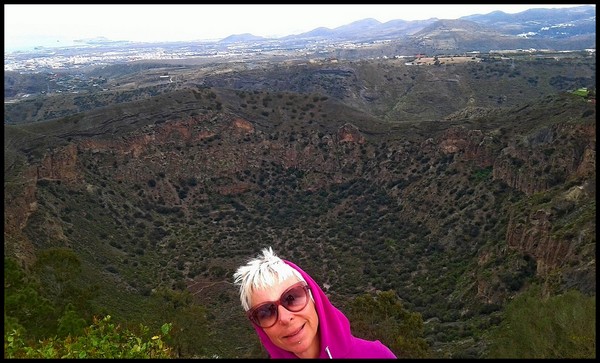
hiking at Caldera Bandama = Gran Canaria
Canary Islands – El Hierro – La Palma – La Gomera – Fuerteventura
I just spent one month at Spain’s far-flung Canary Islands. They’re situated not far off the northwest coast of Africa, closest to the shores of Morocco but have been part of Spain since the 1400s.
There are seven main islands: Gran Canaria, Tenerife, Lanzarote, El Hierro, La Palma, La Gomera and Fuerteventura.
Of those, I visited Gran Canaria. Tenerife and Lanzarote. The primary reason I chose those particular islands is that I had an assignment to review luxury hotels on each island.
I liked Lanzarote the best due to its amazing & bizarre volcanic landscapes and hiking opportunities. I wrote all about Lanzarote in this article.
I also greatly enjoyed Gran Canaria since I had a car to explore all the diverse terrain, including soaring seaside cliffs, rugged mountains, a massive and jagged interior volcanic crater and a few cute historic towns.
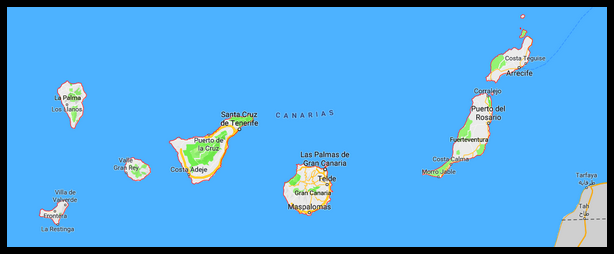 On the other hand, I didn’t care for Tenerife so much. It’s extremely developed, typified by huge freeways with lots of fast traffic, cities with chaotic traffic and difficult roads, and massive coastal tourist areas that are grossly over-developed. Unfortunately, I had to stay in such a region in order to visit the hotels.
On the other hand, I didn’t care for Tenerife so much. It’s extremely developed, typified by huge freeways with lots of fast traffic, cities with chaotic traffic and difficult roads, and massive coastal tourist areas that are grossly over-developed. Unfortunately, I had to stay in such a region in order to visit the hotels.
In hindsight, if I could visit the Canary Islands again, and could do so without the hotel assignments, I’m quite sure I would skip Tenerife altogether and visit the other four, much less visited and more natural islands.
Here’s what I learned about Canary’s less famous islands while researching for an assignment updating a Canary Island Guide…
Perhaps I’ll return one day to explore these islands. They sound awesome!
El Hierro Island
Tiny, triangular-shaped El Hierro is the smallest, most remote and least-developed of the Canary Islands. Yet it has some impressive claims to fame and excellent & diverse natural attractions, making it a fantastic destination for nature lovers.
Most famously, El Hierro is the world’s first island to become 100% environmentally sustainable, now relying entirely on wind, solar and hydro power. The entire island is also UNESCO World Biosphere Reserve. The southern tip additionally has La Restinga Marine Reserve, offering spectacular wall diving and snorkeling.
El Hierro’s diverse & dramatic natural regions include tall cliffs plunging into the sea, spectacular viewpoints, natural rock seaside swimming pools, serene pine forests, strange wind-shaped juniper trees, stark volcanic lava fields, underwater reefs and the island’s most famous feature, called El Gulfo. The huge amphitheater-shaped western Gulfo coast consists of massive scooped-out cliffs covered in green vegetation that plunge down to a flat coastal region.
The island offers dozens of hiking trails in different terrains, dramatic drives on mountain roads, stunning look-out points, kayaking, swimming in natural sea pools and the Canary’s best scuba diving & snorkeling. Travelers who love nature & tranquility and prefer to avoid over-developed tourist areas should definitely consider exploring El Hierro.
Fuerteventura Island
Fuerteventura is the easternmost island of the Canaries, along with neighboring Lanzarote, situated just to the north across a narrow channel. They are both set only 100 km from the coast of Morocco, though no regular boats or ferries run between the islands and Africa.
Like Lanzarote, Fuerteventura is mostly flat with a dry desert-like terrain, more similar to Morocco than the other Canary Islands, which are all dominated by tall volcanic peaks. Also like Lanzarote, Fuerteventura is dotted with weather-worn volcanic peaks, but it also boasts a large central mountain area with lush valleys and quaint historic mountain towns. Much of the central mountains are preserved within the Park de Betancuria, a fantastic hiking area.
Like El Hierro and La Palma Islands, Fuerteventura is also UNESCO Biosphere Reserve. It’s extremely diverse terrain includes the famous golden sand beaches, volcanic cones, stark moon-like volcanic fields, soaring mountains with lush valleys, black stone beaches, goat pastures and sandy desert regions.
Fuerteventura is most renowned as having the best beaches in the Canary Islands. The developed tourist beaches are located at the far southern tip at Morro Jable and the far northern tip at Correlejo. Nearby is National Park Correlejo with even more stunning beaches. But there are also many little-visited natural beaches around the island, particularly along the southeast coast above Morro Jable.
On the northwest coast is the little bohemian surfing and wind-surfing village of El Cotillo. Surfing is also renowned at Isla de Lobos, just off the northeastern tip near Corellejo. Other outdoor activities include hiking and off-road cycling.
Three other important parks are situated on Fuerteventura – Park Natural Jandia, a large mountainous region covering the southern end of the island; Park Mountain Cardon, a bit north of Jandia; and Cuchillas de Vigan, situated on the east coast.
Fuerteventura is also famous for its goat cheeses, some of which now have world class cheese label ‘denominacion de origen’. It’s said that there are more goats than residents on the island.
La Palma
Like El Hierro, La Palma Island is a UNESCO Biosphere Reserve. It’s diverse natural areas include a lush rain forest at Los Tiles, natural sea pools at Piscines de la Fajina, stark volcanic lava fields at Fuencaliente, the island’s large central volcanic crater Taburiente, black sand beaches at Puerto Naos and plenty of scenic drives through lush countryside and steep, winding mountains.
In addition, the island is one of world’s best places for stargazing, to the extent that is has been declared the first UNESCO Starlight Reserve. The Observatorio del Roque de Los Muchachos has one of the world’s largest telescopes. This observatory is sister to the Observatory on Tenerife.
La Palma is most appealing to nature and outdoor enthusiasts. Many hikes of varying lengths and difficulties are found all over the island. In addition, there’s organized rock climbing, rappelling, sea kayaking, scuba diving, mountain biking and volcano climbs.
For cultural pursuits, the capital, Santa Curz de la Palma, is a beautiful historic town dating from the 16th century, that’s packed with stunning historic buildings. During the Canary Island’s world-renowned February Carnival season, La Palma celebrates its famous Dia de los Indianos, where participants vigorously thrown scented talcum powder on everyone in sight (similar to the Indian festival of Hari).
La Gomera
Tiny, round La Gomera is dominated by its soaring central mountain, Volcan Garajonay at 1487M / 4900 ft, which is a national park and Unesco World Heritage site. The island is not far from the southwestern coast of Tenerife and visitors to that part of Tenerife coast can see the entire island on clear days.
In fact, I saw La Gomera every day while I was on assignment at Tenerife. If I had known beforehand it was so close to Tenerife, and relatively inexpensive to reach by ferry, I probably would have made time to go spend a week or so there. Sigh. Maybe next time!
La Gomera’s biggest claim to fame is it’s historic role as the jumping off point for Christopher Columbus’s grand journey across the Atlantic Ocean to the Americas. The island has lots of information and sites relating to Columbus.
The island’s other point of fame is for hiking. Like La Palma and El Hierro, La Gomera offers a huge array of hiking opportunities – in beautiful forests, wild mountains, lush valleys and along empty beaches. Like all the Canary Islands, there are also plenty of narrow, winding mountain & coastal roads to enjoy.
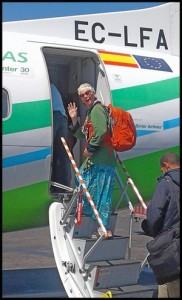
boarding plane in Marrakech to canary islands
Summary
It’s easy to see why these four islands (along with Lanzarote) hold a lot more appeal to me than Canary’s two most popular, tourist-ridden islands of Tenerife and Gran Canaria. I hope I’ll be back one day to explore them and immerse myself in all the fantastic & varied natural places.
You might also enjoy:
My Intro to the Canary Islands
=====================================







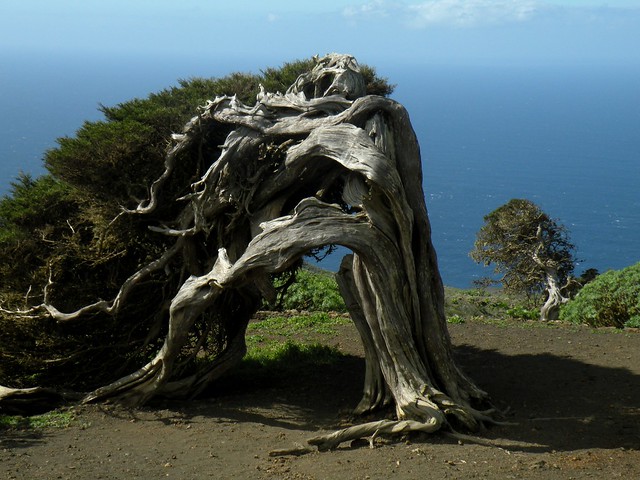

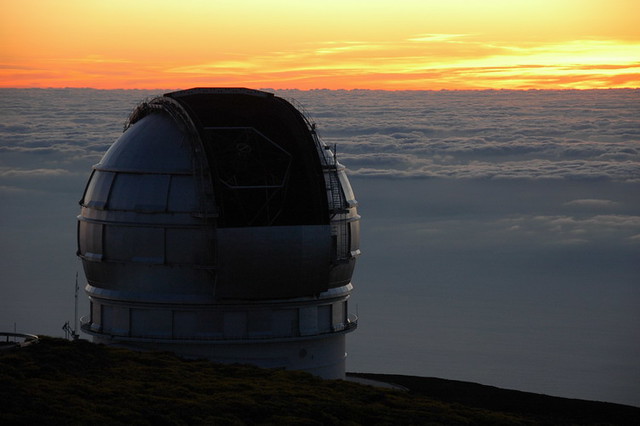
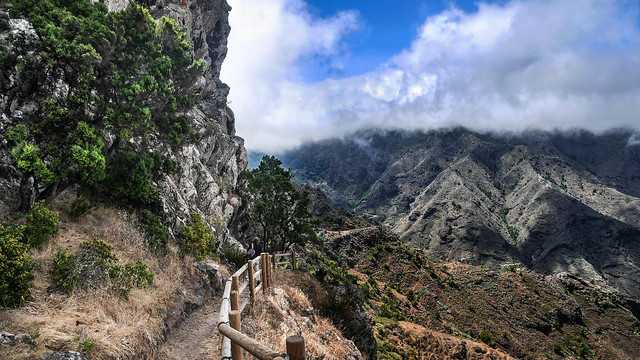





 Hi! I'm Lash, an American nomadic world traveler who's been traveling solo since 1998. I’m passionate about traveling the world nomadically and then sharing it all with you. I hope to inspire you to travel the world, to entertain you with tales from the road, and to help you reach your travel dreams. Welcome!
Hi! I'm Lash, an American nomadic world traveler who's been traveling solo since 1998. I’m passionate about traveling the world nomadically and then sharing it all with you. I hope to inspire you to travel the world, to entertain you with tales from the road, and to help you reach your travel dreams. Welcome! 




1 pings
Canary Islands – All About Tenerife - LashWorldTour
2019/06/13 at 9:41 pm (UTC 8) Link to this comment
[…] El Hierro – La Gomera – La Palma – Fuerteventura Islands […]